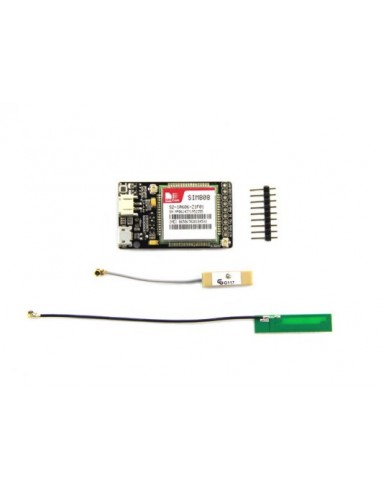





LoNet is a GSM and GPS two-in-one function module. It is based on the latest GSM/GPS module SIM808 from SIMCOM, supports GSM/GPRS Quad-Band network and combines GPS technology for satellite navigation.
It features ultra-low power consumption in sleep mode and integran.
The module is controlled by AT command via UART and supports 3.3V and 5V logical level. It comes with a mini GPS and GSM antenna, but not includes Li-Po battery. In addition, to use this module, you still need an unlock SIM-Card supporting GPRS service.
Features
• Quad-band 850/900/1800/1900MHz
• GPRS multi-slot class12 connectivity: max. 85.6kbps(down-load/up-load)
• GPRS mobile station class B
• Controlled by AT Command (3GPP TS 27.007, 27.005 and SIMCOM enhanced AT Commands)
• Supports charging control for Li-Ion battery
• Supports Real Time Clock
• Supply voltage range 3.4V ~ 4.4V
• Integrated GPS/CNSS and supports A-GPS
• Supports 3.0V to 5.0V logic level
• Low power consumption, 1mA in sleep mode
• Supports GPS NMEA protocol
• Compact size 27mm x 46mm x 7mm
• Standard SIM Card
• Receiver channels: 22 tracking / 66 acquisition
• Coarse/Acquisition code: GPS L1
• Tracking sensitivity: -165dBm
• Cold start time: 30s (typ.)
• Hot start time: 1s (typ.)
• Warm start time: 28s (typ.)
• Horizontal position accuracy: < 2.5m CEP
• Power consumption - Acquisition: 42mA
• Power consumption - Continuous tracking: 24mA
• Update rate: 5Hz
Packing Lists
• 1 x LoNet - Mini GSM/GPRS/GPS Breakout
• 1 x GPS Passive Antenna - 20dB Gain
• 1 x GSM Antenna - 3dB Gain
• 1 x 9Pin Male Header
More info on Seeed's Wiki Page

LoNet is a GSM and GPS two-in-one function module. It is based on the latest GSM/GPS module SIM808 from SIMCOM, supports GSM/GPRS Quad-Band network and combines GPS technology for satellite navigation.
It features ultra-low power consumption in sleep mode and integran.
The module is controlled by AT command via UART and supports 3.3V and 5V logical level. It comes with a mini GPS and GSM antenna, but not includes Li-Po battery. In addition, to use this module, you still need an unlock SIM-Card supporting GPRS service.